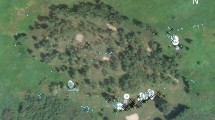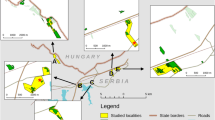Abstract
The Marsh Fritillary butterfly, Euphydryas aurinia (Rott.), is regarded as the classic species that requires landscape-scale management in order to maintain viable populations. This paper describes the background to an extinction of this species in Northern England, United Kingdom, and the action taken to reintroduce and monitor the progress of sub-populations between 2007 and 2009. A captive breeding stock was secured using the last 155 known wild caterpillars in 2004 and supplemented by 95 caterpillars collected under licence from the nearest extant populations in western Scotland. Through captive breeding the source population for subsequent reintroduction was increased dramatically and 42,400 caterpillars were used in 2007 to reintroduce the butterfly to four locations in North and West Cumbria. Each of the release sites is within known historical network areas where the butterfly had thrived in past decades. The intention was to restore multiple habitat patches across each network area and eventually establish viable metapopulations across these landscapes. Adults and larval webs have been monitored since 2007 and show that introduction has been successful at three out of the four locations. The failure at the fourth site appears to be unrelated to habitat condition and the causes are currently being investigated. Work is continuing to secure appropriate management of suitable habitat within each landscape area and the number of sub-populations in one area will be increased in the 2010 season.






Similar content being viewed by others
Notes
Respectively M25 and M24 in the British National Vegetation Classification (Rodwell 1991) .
This can readily be detected by the basal plate of the female genitalia showing as a bare plate, devoid of white scales.
References
Asher J, Warren M, Fox R, Harding P, Jeffcoate G, Jeffcoate S (2001) The millennium atlas of butterflies in Britain and Ireland. Oxford University Press, Oxford
Betzholtz PE, Ehrig A, Lindeborg M, Dinnétz P (2007) Food plant density, patch isolation and vegetation height determine occurrence in a Swedish metapopulation of the Marsh Fritillary Euphydryas aurinia (Rottemburg 1775) (Lepidoptera. Nymphalidae). J Insect Conserv 11:343–350
Bulman CR, Wilson RJ, Holt AR, Bravo LG, Early RI, Warren MS, Thomas CD (2007) Minimum viable metapopulation size, extinction debt, and the conservation of a declining species. Ecol Appl 17:1460–1473
CEC (1992) The conservation of natural habitats and wild fauna and flora (Council Directive 92/43/EEC). CEC, Brussels
Ehrlich PR (1984) The structure and dynamics of butterfly populations. In: Vane-Wright RI, Ackery PR (eds) The biology of butterflies. Academic Press, London, pp 25–40
Ford HD, Ford EB (1930) Fluctuations in numbers and its influence on variation in Melitaea aurinia Rott. (Lepidoptera). Trans R Ent Soc Lond 78:345–352
Fox R, Asher J, Brereton T, Roy D, Warren M (2006) The state of butterflies in Britain and Ireland. Nature Bureau, Newbury, England
Heinrich B (1977) Why have some animals evolved to regulate a high body temperature? Am Nat 111:623–640
Joyce DA (2001) The use of molecular genetics in the formulation of conservation strategies for Lepidoptera. Ph.D. Thesis. University of Birmingham, UK
Junker M, Schmitt T (2010) Demography, dispersal and movement pattern of Euphydryas aurinia (Lepidoptera: Nymphalidae) at the Iberian Peninsula: an alarming example in an increasingly fragmented landscape ? J Insect Conserv 14:237–246
Lei GCN, Camara MKD (1999) Behaviour of a specialist parasitoid, Cotesia melitaearum: from individual behaviour to metapopulation processes. Ecol Entomol 24:59–72
Lei G, Hanski I (1997) Metapopulation structure of Cotesia melitaearum, a specialist parasitoid of the butterfly Melitaea cinxia. Oikos 78:91–100
Lei G, Hanski I (1998) Spatial dynamics of two competing parasitoids in a host metapopulation. J Anim Ecol 67:422–433
Porter K (1981) The population dynamics of small colonies of the butterfly Euphydryas aurinia. D.Phil. Thesis. Oxford University, UK
Porter K (1982) Basking behaviour in larvae of the butterfly Euphydryas aurinia. Oikos 38:308–312
Porter K (1983) Multivoltinism in Apanteles bignellii and the influence of weather on synchronisation with its host Euphydryas aurinia. Ent Exp Appl 34:155–162
Rodwell J (1991) British plant communities, vol 2. Mires and Heaths, Cambridge, England
Schtickzelle N, Choutt J, Goffart P, Fichefet V, Baguette M (2005) Metapopulation dynamics and conservation of the Marsh Fritillary butterfly: population viability analysis and management options for a critically endangered species in Western Europe. Biol Conserv 126:569–581
UK Biodiversity Group (1999) Tranche 2 action plans. Volume IV–Invertebrates. English Nature, Peterborough
Van Sway CAM, Warren MS (1999) Red data book of European Butterflies (Rhopalocera). Nature and environment series No. 99, Council of Europe, Strasbourg
Wahlberg N, Klemetti T, Hanski I (2002a) Dynamic populations in a dynamic landscape: the metapopulation structure of the Marsh Fritillary butterfly. Ecography 25:224–232
Wahlberg N, Klemetti T, Selonen V, Hanski I (2002b) Metapopulation structure and movements in five species of checkerspot butterflies. Oecologia 130:33–43
Warren MS (1994) The UK status and suspected metapopulation structure of a threatened European butterfly, the Marsh Fritillary, Eurodryas aurinia. Biol Conserv 67:239–249
Warren MS, Thomas CD, Thomas JA (1984) The status of the heath fritillary butterfly Mellicta athalia Rott. Biol Conserv 29:287–305 (In Britain)
Acknowledgments
We wish to thank: the enthusiastic volunteers of the Cumbria Branch of Butterfly Conservation for their dedication and hard work in rearing livestock and monitoring the adults and larval webs; the staff in Natural England and farmers who we have worked with to restore and manage habitat for the Marsh Fritillary; staff of the National Trust, National Park and Environment Agency who have provided support and funding to secure sites; and finally to the horticultural skills of Messrs R and J Bennett who have supplied rearers and farmers with many thousands of S. pratensis plants.
Author information
Authors and Affiliations
Corresponding author
Rights and permissions
About this article
Cite this article
Porter, K., Ellis, S. Securing viable metapopulations of the Marsh Fritillary butterfly, Euphydryas aurinia, (Lepidoptera: Nymphalidae) in Northern England. J Insect Conserv 15, 111–119 (2011). https://doi.org/10.1007/s10841-010-9328-9
Received:
Accepted:
Published:
Issue Date:
DOI: https://doi.org/10.1007/s10841-010-9328-9




